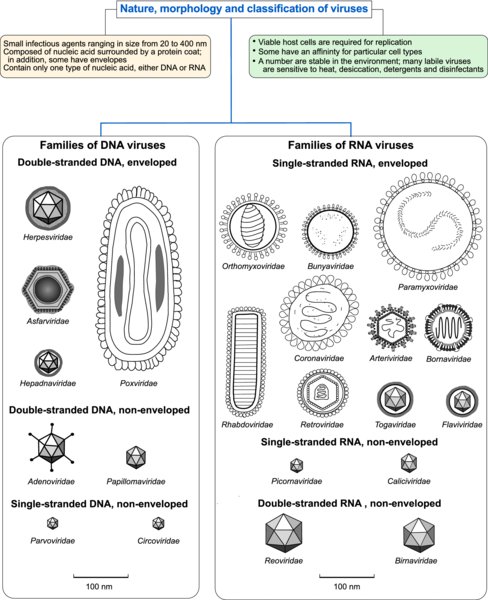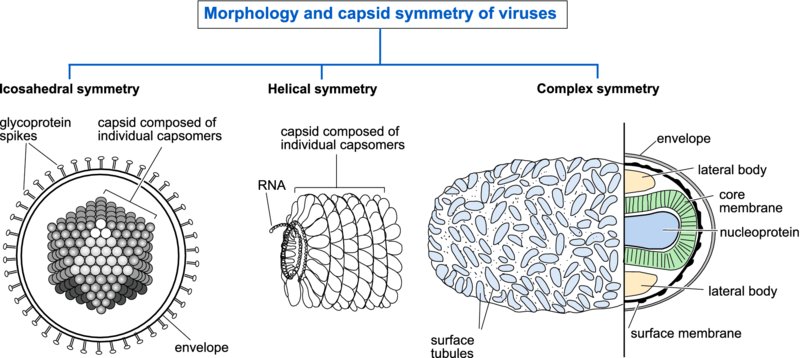50 Nature, structure and taxonomy of viruses


The term ‘virus’ (Latin virus, poison) refers to members of a unique class of infectious agents which are extremely small, contain only one type of nucleic acid and are dependent on living cells for replication (Box 50.1). The genomes of the viruses which infect animals are smaller than those of prokaryotic cells, ranging from about 2 kbp to 800 kbp. In most viruses, the nucleic acid is present as a single molecule; in some RNA viruses the nucleic acid occurs in separate segments. Although the nucleic acid of viral genomes is usually linear, in some viruses it is circular. Genomes of DNA viruses can be single-stranded or double-stranded.
A fully assembled infective virus is termed a virion. The fundamental component of the virion is a nucleoprotein core with the ability to infect host cells and replicate in them, thus ensuring continued survival. The genome of vertebrate viruses is enclosed within a shell of proteins, called a capsid. Each subunit of the capsid is composed of a folded polypeptide chain. Collections of these subunits constitute structural units or protomers which, in turn, comprise assembly units. The term ‘capsomer’ or ‘morphological unit’ is used to describe features such as protrusions seen on the surface of virus particles in electron micrographs. These structures often correspond to groups of protein subunits arranged about a local axis of symmetry. Capsids are composed
of multiples of one or more types of protein subunits. The utilization by viruses of a small number of repeated protein subunits ensures minimal cost in coding space. The orderly arrangement of similar protein–protein interfaces results in a symmetrical structure. Icosahedral and helical symmetries are the types of capsid symmetry described in viruses.
Closed-shell, isometric viruses have a structure based on icosahedral symmetry. This structural form offers the maximum capacity and greatest strength for a given surface area. The protective, helical capsid of many RNA viruses is formed by the insertion of protein subunits between each turn of the nucleic acid helix.
In many types of viruses, the nucleocapsid is covered by an envelope composed of a lipid bilayer and associated glycoproteins. The envelope is acquired when the nucleocapsid buds through a membrane of the cell. Proteins, encoded by viral nucleic acid and integrated as glycoprotein into the appropriate membrane by the compartmentalization mechanisms of the host cell, are an integral part of the viral envelope. Peplomers or spikes are knob-like projections on the envelope of certain viruses. These structures are formed from oligomers of surface glycoproteins.
Taxonomically, viruses are assigned to five main hierarchical levels, namely order, family, subfamily, genus and species. The species taxon is regarded as the most important level of classification. A virus species is defined by a combination of multiple properties and characteristics; no single or unique property is essential for species definition. In the present scheme of virus taxonomy, the primary delineating criteria are the type and nature of the genome, the mode and site of viral replication and the structure of the virion. Currently, more than 1,900 virus species are recognized by the International Committee on Taxonomy of Viruses, with the periodic addition of new species. In addition, international specialist groups monitor large numbers of strains and subtypes. No universal agreement on terminology appropriate for description of strains and subtypes of virus species has been ratified internationally.